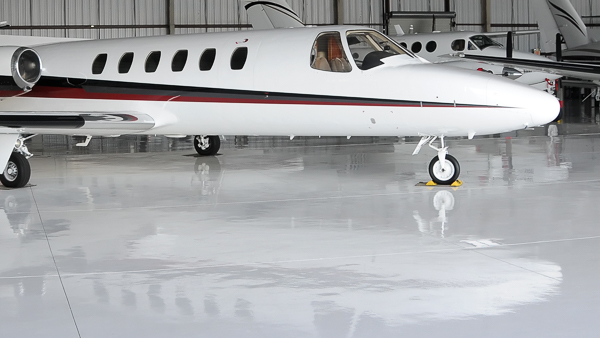The coating chosen for an aircraft hangar floor has a unique job to do. Choosing the right hangar floor coating system is critical to making sure the hangar floor not only looks professional and is durable, but it is also a reflection on the quality of the aircraft stored there.
As a pilot and having owned a hangar, I know there is something special about walking inside and seeing an airplane that’s ready to fly. It’s as if it’s on display in an aircraft showroom floor. Whether it’s a piston single or a sleek bizjet, just seeing the airplane displayed on the best hangar floor possible raises the excitement factor on flight and travel.
The hangar floor plays a role in that excitement. A gleaming, glossy concrete floor creates a completely different feeling than seeing an airplane on a cracked, dirty, floor with peeling paint. Not only does the look come into play, but there’s the notion of how well the facility is cared for and that mirrors how the airplane is maintained.
But an ideal airplane hangar floor must do more than just offer good looks. It needs to resist abrasion and resist tire marking from the aircraft tires, often hot and dirty when being rolled in after a flight. And it has to accommodate maintenance crews who might roll in heavy tool boxes and equipment, drop tools, and occasionally spill chemicals like Skydrol and engine oils.
And you want a durable hangar floor that lasts. No one wants to refinish floors frequently. It’s not in the budget.
Hangar floor coatings are important. They are almost always applied as systems: primer, mid-coat and topcoat. CFI’s concrete coating systems for aircraft hangar floors are designed to deliver the right system for your needs. To help you select the best concrete floor coating system hangars, here are four things you need to think about.
The Environment
As with just about any indoor/outdoor concrete floor, the environment where the hangar is located is the first thing you need to think about.
To a very large degree, the environment affects the kind of wear and punishment the floor will have to endure. Hangars located in northern climates could be subjected to snow, ice, water and salt, whereas in the south, high heat and humidity are more prevalent. In the southwest, airport operators have to worry about sand and grit. Everywhere there are temperature swings.
And then there is the impact of the sun’s ultra-violet radiation, or UV. Large hangar doors expose the floors to direct sunlight, especially if the doors face south (or for those in the Southern Hemisphere, face north). Without the right coating products, the floor can yellow. Choosing the right hangar floor coating to avoid yellowing makes a difference in the floor’s looks and how long it lasts.
Primary Use
The second consideration when choosing the right concrete coating for an aircraft hangar floor is how the floor will be used.
Hangars used just for storage and light maintenance have different floor coating needs than those used for heavier maintenance and repair. Tools, handcarts, oil and fuel, and wheeled equipment can damage a shiny new concrete floor if the wrong system is chosen.
Even the size of the aircraft makes a difference. Larger aircraft towed out with a motorized tug can cause greater damage to a floor than the aircraft itself, and certainly more damage than that caused by smaller airplanes that can be pulled in and out by hand or a small two-wheeled tug.
New or Existing Floor
If you’re pouring a new concrete hangar floor, all you have to worry about is the future and how the floor will be used. That makes the hangar floor coating specification relatively easy.
But for existing floors, you need to know how that floor was used in the past. If it was used for heavy maintenance, there is a good chance oil and other chemicals have seeped into the concrete. Those substances can damage a new coating from underneath.
Something else to think about for existing floors is return-to-service (RTS). Most likely, you’ll want you’ll want the aircraft parked on the ramp for as short a time as possible, so you may prefer a coating system that cures fast and is quickly ready for service.
The Look
Finally, you should think about how you want your hangar floor to look and whether you need stripes. A good-looking floor goes a long way toward instilling confidence in aircraft owners that their airplanes are well cared-for. This may be especially true for high-end jet aircraft hangar floors where the owners expect perfection.
As you consider the look, you can consider whether you want a high-gloss look, a matte finish, something with colored flake, quartz or sand. Each of those not only offers a unique aesthetic, but also offer different performance and durability capabilities.
No matter what, you’ll want to select an aircraft hangar coating system that offers the image you want yet meets the performance standards you need.
Check out concrete coating systems for aircraft hangar floors anytime.

